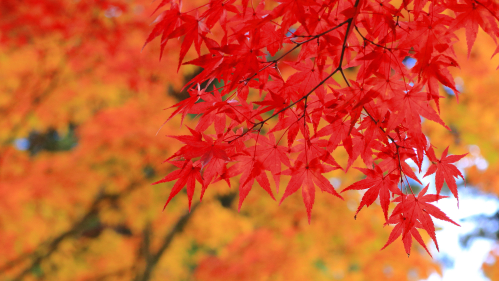Why Do Leaves Change Color?

What is the chemistry that causes all those beautiful hues to appear in the fall. Jason Grabosky, a professor and program director of Urban Forestry in the School of Environmental and Biological Sciences, explains the process that makes leaves change color, the factors that influence the shades that we see and the importance of simply taking the time to stop and enjoy the colors.
The first question is why do leaves change color?
Leaves change color when chlorophyll – a substance plants use to turn light into sugar that makes a leaf look green – is breaking down and the plant is not rebuilding replacement molecules as the days get shorter. Other pigments, a class called the carotenoids, show as yellow and contribute to the appearance of orange and brown. Carotenoids are always on some level in the leaf, but instead of being overwhelmed by the green as they are in the summer, they appear as the chlorophyll, and thus the green, fades away. The reds are from a more “expensive to make” pigment, anthocyanin, and they develop in fall. The reds and yellow together give us the orange fall colors in some tree species.
What factors affect the colors we see?
The big factors are the length of day, temperature and the weather. The change in the length of day triggers several processes to get ready for the autumn and winter. These changes can influence the shift in color to occur. Temperature can induce or accelerate those changes. Light also plays a role. Light energy is used to make anthocyanin, so sunny days can intensify the color development. Wind/rain are mechanical forces which can cause the leaves to detach and fall. Since different tree species hold their leaves (and thus lose their leaves) in different ways, wind and rain can influence what is present in the plant community “color palette” on a landscape scale.
How does weather play a role?
You hope for sunny days and cool (some say cold) nights. Then you see vibrant and clearer colors. Rainy or heavy cloud cover, warmish longish autumns can dull the colors, but fall colors are still awesome, even on cloudy days.
Is there anything else that influences the color of leaves?
Our perception and how we individually see things and react to those stimuli plays a role in our reaction to fall colors. We lost a number of leaves this year in the hot-dry period several weeks ago, yet for the leaves that we have, we see an awesome display. How observant we are to notice and taking the time to notice is what matters. If water becomes limiting, the leaves will dry out and fail to thrive in the transition long enough to put on this glorious show.
When will the color peak in New Jersey?
I noticed some sugar maple showing some nice color on the Cook/Douglass campus, so the shift has begun. Sunny days and cool clear nights will enable a good show of the reds and oranges. I expect some good color late next week in the north and west areas of the state. The peak color shifts southward over the following week, and of course the color shifts with the change in species that make up the forests as we move from north to south and from the highlands to the coast. Get out and look now. Look often. Slow down and walk across campus for some amazing color this week and next week. Some trees simply glow in the late afternoon light, and that could be as soon as next week. Even after the color show, there are awesome browns in the oaks and young beech leaves have a great light brown all winter.
For those of us not looking forward to raking: When will the leaves all be gone from the trees?
A good bet is after a hard rain after the first hard frost. But what is wrong with raking? It is a great activity since you can take it on at a healthy pace. It is a motion meditation on the cycle of our environment, and our place within it. In these hard times, maybe we need to slow down and re-engage, and maybe even talk with our neighbors. You can also keep the leaves and use them instead of fertilizer, you can mow, crush, compost those leaves, and in a natural system that builds your soil and sustains your forest canopy or landscape.


